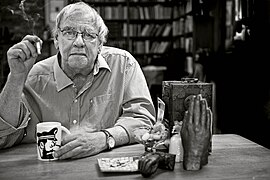Jeroen Brouwers's Human Design Chart
3/5 Emotional ManifestorDutch journalist, translator and prophilic writer who made his literary debut in 1964 with Het mes op de keel (The Knife to the Throat).
He was the fourth child of five of Roman Catholic parents. His father Jacques Theodorus Maria Brouwers (12 January 1903, Den Bosch – 28 December 1964, Delft) was an accountant in an architect firm. His mother Henriëtte Elisabeth Maria van Maaren (2 May 1908, Amsterdam – 27 January 1981, Delft) was the daughter of the musician Leo van Maaren (1885– 27 July 1945, Semarang). They married on 1 August 1928 at Bandung.
On 5 March 1942, Batavia fell to the Japanese. In 1943 his father was sent as a POW to Tokyo. He, his mother, sister and grandmother were taken prison in the Japanese internment camps for women and children, first in Kramat and some months later in Tjideng (1943-1945). As a toddler (age 3-5) he was confronted with the separation from his father, the death of friends and of his grandmother (Elisabeth Henrica Pos 1885-1945) of exhaustion and disease and the emaciation and humiliation of his mother. From April 1944 the Tjideng camp was under the command of Captain Kenichi Sonei, who was responsible for many atrocities. Sonei was sentenced to death on 2 September 1946.
Following the surrender of Japan, Indonesia declared its independence on 17 August 1945. Jeroen’s mother and children returned to the Netherlands in 1947. In 1948 their father followed them. Until 1950 Jeroen lived at home. But at age 10, he was sent to several Roman Catholic institutions, because he needed special psychological care. He had difficulties adjusting to normal life after his traumatic camp experiences in Indonesia. But his spiritual care-takers had no experience with the evil concentration camps.
Brouwers left the secondary MULO school in 1955. From 1958–1961 he had military service, after which he started working as an apprentice journalistic for De Gelderlander, a Dutch provincial newspaper (1961). In 1962 he became an editor of Romance magazine (later renamed as Avenue). From 1964 to 1976 he was editor of Publishing company Manteau in Brussels. After a conflict with Julien Weverbergh (26 May 1930, Antwerp), Brouwer left Manteau and became a successful professional writer.
In 1983, he published the essay “De laatste deur” about suicidal writers. In the Dutch Journal for Psychiatry, H. Corthals concluded in his essay “On psychiatry and literature” with Brouwers that the suicide rate under writers was not higher than in the general population, but that psychiatrists were at high risk. As writers (but not psychiatrist writers) could sublimate the risk.
In 1981, after the death of his mother, Brouwers wrote Bezonken rood (translated in 1988 as “Sunken Red”) about his devastating life experiences in the Japanese camps.
He translated works of Robert Walser, Kurt Tucholsky and Gottfried August Bürger (Münchhausen) into the Dutch language. He also wrote biographies of Edith Piaf and Louis Couperus.
He got many of the major literary awards of the Dutch and Flemish governments, including the Multatuli (1980) and Constantijn Huygens Prize (1993.) But he refused the prestigious “Prijs der Nederlandse Letteren” (2007), which was in his eyes insultingly low (€16,000).
Jeroen Brouwers died on 11 May 2022 at age 82 in Maastricht, Netherlands.
Link to Wikipedia
Discover More Famous People
Browse and analyze over 55,000 public figures and celebrities.
Ra Uru Hu
5/1 Manifestor
Martha Stewart
4/6 Manifestor
David Lynch
4/6 Generator
Barack Obama
6/2 Projector
Steve Jobs
6/3 Generator
Vladimir Putin
5/1 Manifestor
Kim Kardashian
3/5 Generator
Michael Jackson
1/3 Projector
Marilyn Monroe
6/2 Projector
Ariana Grande
2/4 Projector
Oprah Winfrey
2/4 Generator
Johnny Depp
2/4 ManifestorWhat is HumanDesign.ai and how does it work?
Curious what makes Jeroen Brouwers tick? HumanDesign.ai instantly maps their exact birth data into a fully interactive clickable bodygraph chart, letting you hover or tap every center, channel, and gate for plain-language explanations. Bella, the platform’s built-in AI guide, adds context in real time, translating complex mechanics into everyday insights so you can see how Jeroen Brouwers’s strengths, challenges, and life themes play out on-screen.
The same tools are waiting for you. Generate your own Human Design Chart in seconds, open a library of 2000+ suggested questions, and chat with Bella as often as you like to decode your design, daily transits, and even relationship dynamics.
Want to compare energies? Save unlimited charts for friends, family, or clients, then ask Bella to reveal compatibilities, composite patterns, or coaching tips, all in one conversation thread.
Start free with core features, or unlock our Personal and Pro plans for deeper dives: unlimited Q&A, celebrity chart search spanning 55,000+ public figures, white-label PDF reports, branded content generation, and a professional profile with built-in booking for practitioners. Whether you’re exploring your own potential or guiding others, HumanDesign.ai delivers an ever-expanding toolbox of AI-powered insights—no spreadsheets, no jargon, just clarity at your fingertips.
Ready to see yours? Signup for FREE today!

